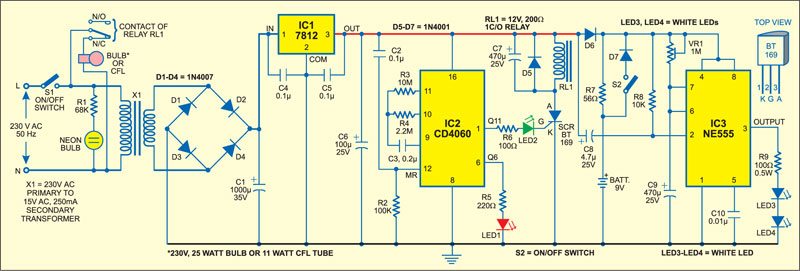 Sometimes we forget to switch off the bathroom light and it remains on unnoticed for long periods. This automatic bathroom light circuit solves the problem of electricity wastage by switching off the lamp automatically after 30 minutes once it is switched on. The back-up LED lamp provided in the circuit turns on for three minutes when mains fails. This is helpful especially when you are taking a shower at night.
Sometimes we forget to switch off the bathroom light and it remains on unnoticed for long periods. This automatic bathroom light circuit solves the problem of electricity wastage by switching off the lamp automatically after 30 minutes once it is switched on. The back-up LED lamp provided in the circuit turns on for three minutes when mains fails. This is helpful especially when you are taking a shower at night.
Automatic bathroom light circuit
The circuit is built around binary counter CD4060 (IC2), which has a built-in oscillator and 14 cascaded bistable multivibrators. The oscillator generates clock pulses based on the values of resistors R3 and R4 and capacitor C3.

For the given values, Q11 output of IC2 goes high after 30 minutes of power-on. Resistor R2 resets the IC for proper operation. The output of IC2 is fed to the gate of the SCR via resistor R6 and LED2, which function as a voltage dropper as well as output status indicator.
Circuit operation
When the SCR gets gate drive, it fires to energise relay RL1. The latching function of the SCR keeps the relay energised until the power to the circuit is switched off using switch S1. When the relay energises, its normally closed (N/C) contacts break and light turns off. LED1 indicates that the oscillator is working.
The back-up white-LED lamp comprising LED3 and LED4 gives ample light in the event of mains failure. It is powered by a 9V rechargeable battery, which is charged at around 200mA current via diode D6 and resistor R7 when the circuit is switched on.
The back-up lamp circuit is built around timer NE555 (IC3) designed as a monostable. The output of IC3 goes high for three minutes based on the values of preset VR1 and capacitor C9. When the circuit is switched on, IC3 gets power supply via diode D6 and its trigger pin 2 remains high due to resistor R8. As a result, its output remains low as long as mains is present.
When power fails, pin 2 of IC3 get striggered via capacitor C8 and the monostable output goes high to switch on the white LEDs (LED3 and LED4). Resistor R9 limits the current through the LEDs to a safe level. Diode D7 is forward biased to give full voltage to the monostable when power fails.
The power supply for the circuit is derived from a 15V AC, 250mA transformer. The secondary output is rectified by a full-wave rectifier comprising diodes D1 through D4. Capacitor C1 smoothes the resulting DC. Regulator IC 7812 (IC1) and capacitors C4 and C5 provide stabilised 12V for the circuit.
Construction & testing
Assemble the circuit on a Veroboard and enclose it in a watertight plastic case. Connect the bathroom lamp (either 25-watt bulb or 11-watt CFL tube) to the circuit via N/C contacts of the relay, so that it turns on when switch S1 is pressed. For easy access, fix switch S1 along with the neon indicator outside the bathroom.
The article was first published in March 2005 and has recently been updated.










can you provide the pcb layout of Automatic Bathroom Light with Back-up Lamp
Please contact [email protected] for the same
Comment: You project are good and i need a copy from title automatic bathroom light with back up- lama
PLease elaborate your query.
I cannot find components in proteus. can you please provide the circuit diagram for proteus.